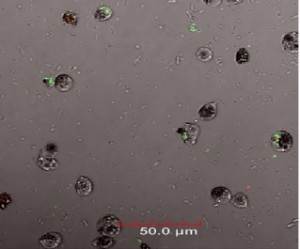We have many years of experience with phagotrophic algae (algae that can eat particles and other small bacteria). Much of our algae research is focused on developing patent-pending processes that employ unique bioprocesses to promote the establishment of stable and desirable algae species, preferably with high oil content. With our versatile process, algae can be used as viable method for waste treatment, oil collection, and organic removal. As an added benefit, algal lipids can be collected and converted to biodiesel. The process can be tailored to simultaneously remove organic, nitrogen-containing, and phosphorus-containing materials from the waste stream (most commonly in waste water). With the overall costs reduced by the optional biodiesel production and simplified wastewater treatment, these processes are expected to have very favorable overall economics.
The ultimate scale and sustainability of biodiesel industry depends on successful development of non-food renewable feedstock. Some algae have very high oil (lipid) contents (50-70% dry weight). These algal lipids have similar compositions as vegetable oil and are readily adoptable as feedstock to the existent biodiesel manufacturing processes. Algae technology promises a non-food and renewable biodiesel feedstock. This goal has long been recognized, yet pursued from the approach of photosynthetic cultivation, which is conceptually attractive but practically difficult. While algae are indeed capable of growing in very simple aqueous media with sunlight as energy source and CO2 as carbon source, the culture’s self-shading and light saturation properties prevent the light from penetrating beyond small depths and waste a large fraction of light energy as heat. This approach is therefore limited to use very shallow ponds (thus, requiring large land use) and achieve low productivity, unacceptable to production of high-volume low-value industrial products such as biodiesel.
We have developed a versatile algal platform to convert waste organics into algal biomass and lipids. Our algal platform utilizes a unique species of algae that is capable of growing on dissolved organics, consuming smaller bacteria, and using photosynthesis when available. Therefore, this species of algae does not rely on light penetration and allows for much higher cell concentrations (~20 g/L dry weight). Furthermore, this algae is also rich in lipids (~40%) and the lipid content can be increased up to 70% by weight. Our studies demonstrate that this algal platform can be successfully applied to both soluble waste organics (wastewater) and solid waste organics (waste sludge).

Microscopic image showing the ingested bacteria in algal cells (small green dots are bacteria)
Patents:
Multi-step method for producing algae products(#WO 2009088839 A3)
Algae having intracellular lipid particles and high lipid content (#US 20140038247 A1)
Producing algal biomass and products from organic solid material (#WO2014194174 A1)
Publications:
Cultivation of phagotrophic algae with waste activated sludge as a fast approach to reclaim waste organics (Cong Li , Suo Xiao, and Lu-Kwang Ju) Water Research, 91, 105-202 (2016). Article
Conversion of wastewater organics into biodiesel feedstock through the predator-prey interactions between phagotrophic microalgae and bacteria. Cong. Li, Lu-Kwang Ju. RSC Advances 4 (83), 44026-44029.
Microalga Ochromonas danica fermentation and lipid production from waste organics such as ketchup. (Z. Lin, A. Raya, L.-K. Ju) Process Biochemistry (in press, published online 6/3/2014). Article